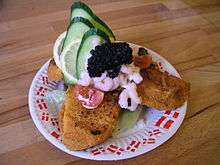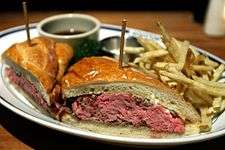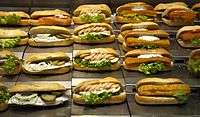Smørrebrød
|
| |
| Type | Open Sandwich |
|---|---|
| Place of origin | Denmark |
| Main ingredients | Rugbrød, butter, pålæg (cold cuts, pieces of meat or fish, cheese or spreads) |
Smørrebrød (Danish pronunciation: [ˈsmɶɐ̯ˌbʁœðˀ]; originally smør og brød, "butter and bread") usually consists of a piece of buttered rye bread (rugbrød), a dense, dark brown bread. Pålæg (literally "on-lay"), the topping, that among others can refer to commercial or homemade cold cuts, pieces of meat or fish, cheese or spreads. This daily practice is the base of the famous Danish open sandwich, smørrebrød: a slice or two of pålæg is placed on the buttered bread, and then decorated with the right accompaniments, to create a tasty and visually appealing food item.
Bread
Bread is a very important part of the Scandinavian table, primarily rugbrød, which is sour-dough rye bread. It is a dark, heavy bread which is often bought sliced, in varieties from light-coloured rye, to very dark, and refined to whole grain. It forms the basis of smørrebrød, which is closely related to the Swedish smörgås. Some toppings are served on franskbrød, a very light, crusty wheat bread. The bread is usually buttered, though for some variants, a spread of lard is customary.
Toppings

Traditional toppings include marinerede sild, which are pickled herrings (plain, krydret – spiced, or karry – curried), slightly sweeter than Dutch or German herrings; thinly sliced cheese in many varieties; sliced cucumber, tomato and boiled eggs; leverpostej, which is pork liver-paste; dozens of types of cured or processed meat in thin slices, or smoked fish such as salmon; mackerel in tomato sauce; pickled cucumber; boiled egg, and rings of red onion. Mayonnaise mixed with peas, sliced boiled asparagus and diced carrot, called italiensk salat (lit. Italian salad, so named because the colours match the Italian flag), remoulade or other thick sauces often top the layered open sandwich, which is usually eaten with utensils. It is custom to pass the dish of sliced breads around the table, and then to pass around each dish of toppings, and people help themselves.
More festive meals can be loosely divided into courses: Fish toppings first (such as herring, shrimp, or smoked salmon) followed by cold cuts and salads, and finally cheese with bread or crackers and a little fruit. One or several warm dishes are often served with the meats on special occasions: For example breaded plaice filet, fried medister sausage, frikadeller with pickled red cabbage, or mørbradbøf (pork tenderloin with sauteed onions or a creamy mushroom sauce). Toppings change with the seasons and some are mostly associated with Easter or Christmas lunches, like sylte (head cheese) and æbleflæsk (roast pork or bacon in apple sauce). Summer offers lighter fare such as smoked mackerel, sommersalat (radish and cucumber in a smoked cheese dressing), new potatoes, and freshly peeled shrimp.
Hundreds of combinations and varieties of smørrebrød are available, and some traditional examples include:
- Dyrlægens natmad (Danish: Veterinarian's midnight snack) — On a piece of dark rye bread, a layer of liver pâté (leverpostej), topped with a slice of salt beef (salt kød) and a slice of meat aspic (sky). This is all decorated with raw onion rings and garden cress.
- Eel — Smoked eel on dark rye bread, topped with scrambled eggs and sliced radishes or chopped chives.
- Leverpostej — Warm rough-chopped liverpaste served on dark rye bread, topped with bacon, and sauteed mushrooms.
- Roast beef — thin sliced and served on dark rye bread, topped with a portion of remoulade, and decorated with a sprinkling of shredded horseradish and toasted (ristet) onion.
- Roast pork (Ribbensteg) — thin sliced and served on dark rye bread, topped with red sweet and sour cabbage, and decorated with a slice of orange.
- Spiced meat roll (Rullepølse) -- thin sliced and topped with meat aspic, raw onion rings and garden cress.
- Tartar — raw lean beef mince with salt and pepper, served on dark rye bread, topped with raw onion rings, grated horseradish and a raw egg yolk.
- Smoked salmon (laks) — Slices of cold smoked or cured salmon (gravad laks) on white bread, topped with shrimp and decorated with a slice of lemon and fresh dill.
- Stjerneskud (Danish: Shooting Star) — On a base of buttered white bread, two pieces of fish: a piece of steamed white fish on one half, a piece of fried, battered plaice (rødspætte) on the other half. On top is piled a mound of shrimp, which is then decorated with a dollop of mayonnaise, red caviar, and a lemon slice.
A lavish piece of restaurant smørrebrød can almost be a meal unto itself, whereas everyday toppings are much simpler and often ungarnished.
References
Literature
- Katrine Klinken, Smørrebrød – Danish open, Thaning & Appel, 2008.
- Ida Davidsen and Mia Davidsen, Open your heart to the Danish open – : the Davidsen dynasty and their best recipes, Lindhardt og Ringhof, 2006. ISBN 978-87-614-0400-8.
- Inge Lotz, Danish open sandwiches, Aschehoug Fakta, 1997. ISBN 87-7512-668-0.
External links
| Wikimedia Commons has media related to Smørrebrød. |
- Dine with the Danes Video of Danish open-face sandwiches

